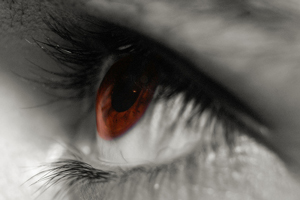
Source: Points of View [Explored], Riccardo Cuppini, Flickr
Now that you know that authors have a choice as to which point of view they are going to use, it’s time to figure out how to distinguish one point of view from another. To do that, you’ll need to identify the narrator of the story and look at pronouns. When you are trying to determine the point of view of a text, keep in mind that dialogue can be a source of confusion. Just because a narrator speaks in first person (I, me) or third person (he, she, him, her) does not mean that the entire story is written from that point of view.
Here are the pronouns again. This time, though, they have been separated into two charts, one with singular pronouns and one with plural pronouns. Each chart has labels so you can see how the pronouns are used. You can refer to these charts throughout the lesson.
- First person
- Third-person limited
- Third-person omniscient
| Singular | Subjective | Objective | Possessive |
|---|---|---|---|
| 1st person | I | me | my, mine |
| 3rd person | he, she, it | him, her, it | his, her, hers, its |
| Plural | Subjective | Objective | Possessive |
|---|---|---|---|
| 1st person | we | us | our, ours |
| 3rd person | they | them | their, theirs |
First person

Source: Hanging Out At School, Geoffery Kehrig, Flickr
As you know, if a story is written in first person, a character within the story is narrating the events using the pronouns that you would use when talking about yourself—first-person pronouns. A story written in first person would look like this:
I went to soccer practice this afternoon, and I saw my friend John. He told me to call my mom right away. I had no idea what it was all about. I hoped that she was going to tell me that my new guitar had arrived. When I called, my mother told me that Mr. Post had found a set of keys behind the garage, and they were mine.
Notice the first-person pronouns I, my, me, and mine. They are used to allow the reader to see that the character is right there in the story, not outside the action. This style of writing tends to make the reader feel very close to the action in the story. One interesting drawback to this point of view is that the reader can be left wondering if the character is reliable or telling the whole truth about the story. In other words, if the story is written solely from the point of view of one person—and given that no person is perfect—a reader might question some of the statements and judgments of the character around whom the story revolves. A good example of this is the character Bud Caldwell in the novel Bud, Not Buddy. Bud is only ten-years old, but he has to deal with many hardships during the course of the book, leaving the reader to wonder how the story would unfold if another, even older, narrator told it.

Source: Reading a book in the sunshine, and pretending that I don't even care if anyone is watching me ..., Ed Yourdon, Flickr
Examples of works of literature written in first person are
- The Outsiders, narrated by the character Ponyboy Curtis,
- Stargirl, narrated by the character Leo Borlock; and
- Roll of Thunder Hear My Cry, narrated by the character Cassie Logan.
 Now, it’s your turn. Use your notes to respond to the following writing prompt. Make sure your response is written from a first-person point of view. When you are finished, check your understanding to see a sample response.
Now, it’s your turn. Use your notes to respond to the following writing prompt. Make sure your response is written from a first-person point of view. When you are finished, check your understanding to see a sample response. Imagine that you are late for soccer/band/club practice. It’s the second time this week, and you are a little nervous about what the teacher/coach/leader will say to you. Write a short paragraph in first person describing what takes place when you show up.
I round the corner of the school only to see the whole team standing outside the gym door. My stomach drops to my knees. My mind starts rehearsing the speech I had practiced as I walked to practice. My best friend shakes his head at me. As I approach the door, it swings open, and I now see my coach. He isn’t smiling.
Third-person limited

Source: Untitled, Leon Rice-Whetton, Flickr
A story written in third-person limited is different from first person. In third-person limited, the narrator describes the action of the story from the viewpoint of one single character, hence the limited description. Readers see that character through the narrator’s eyes, not through the character’s eyes as they would in a first-person story. Think of the difference like this: In first person, the narrator is a character within a story describing his or her thoughts and actions. In third-person limited, the narrator is outside the story focusing on the thoughts and actions of a single character. Another difference between the two points of view is the choice of pronouns: I, me for first person and he, she, it for third-person limited. You will find sentences such as the following in a story written in third-person limited. Notice the use of the third-person pronouns she, her, and he.
Hannah stood with her friends as she watched Billy stomp out of the room, slamming the door behind him. Hannah knew it would be hard to conceal her happiness at seeing him leave, so she didn’t even try. “Yes!” she exclaimed.
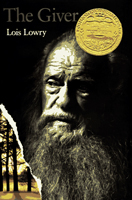
Source: The Giver Cover, 1, Wikipedia
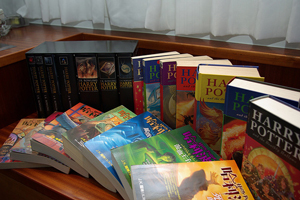
Source: Harry Potter book series, Hung Chieh Tsai, Flickr
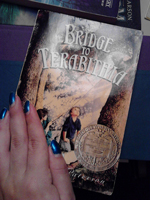
Source: "Bridge To Terabithia", selected by Rosie Artist, CSUF Public Library, Flickr
Examples of works of literature written in third-person limited point of view are
- Bridge to Terabithia in which the narrator focuses on Jess,
- Harry Potter in which the narrator focuses on Harry Potter, and
- The Giver in which the narrator focuses on Jonas.
Third-person omniscient
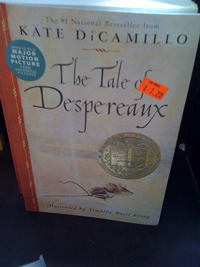
Source: The Tale of Desperaux, Meggle, Flickr
Third-person omniscient point of view is similar to third-person limited point of view because they share the same set of pronouns: he, she, it, they. But the similarity ends there. A third-person omniscient narrator reports from outside the story’s action. Instead of focusing on one character’s perspective (as is done in third-person limited), the narrator focuses on all the characters and events. The narrator is said to be omniscient, or all-knowing.
The third-person omniscient point of view allows the greatest flexibility and reliability when relating the events of a story. In terms of flexibility, the narrator can jump around from one character to another in order to give the reader a well-rounded picture of the action. In terms of reliability, having a narrator who can give the reader different perspectives from a number of characters allows for a more accurate portrayal of what is taking place.
Here is an example of third-person omniscient writing. Notice the pronouns (his, he, she, them) are the same pronouns used in third-person limited writing. The difference between the two lies in the fact that the third-person omniscient narrator can reveal the thoughts and feelings of all the characters while the narrator in the third-person limited story can reveal those of only one of the characters.
Tim nervously approached his friends, feverishly trying to figure out what he was going to say. Marty’s lips twitched expectantly. She had warned Robert that if Tim decided to lie to them, she would find it difficult to stay silent.
Examples of works of literature written in third-person omniscient point of view are
- Little Women by Louisa May Alcott,
- The Tale of Despereaux by Kate DiCamillo, and
- The Phantom Tollbooth by Jules Feiffer.
You have been introduced to the three points of view: first person, third-person limited, and third-person omniscient. Try your hand now at identifying them in literature. Read each excerpt below and select the correct point of view label from the drop down list under the text box. Remember to look at the pronouns and at the narrator to determine which point of view is used.

Now that you know how to identify points of view, you can practice your new skill even more in the next section.